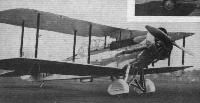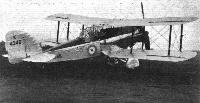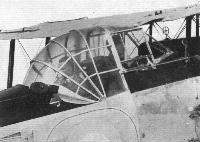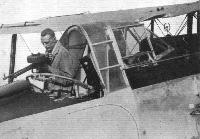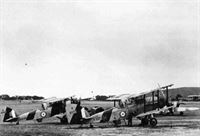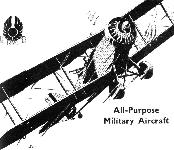
Варианты
- Westland - Wapiti - 1927 - Великобритания
- Westland - Wallace / PV.3 / PV.6 - 1931 - Великобритания
Westland Wallace
P.V.3, разработанный в инициативном порядке легкий торпедоносец-бомбардировщик, и P.V.6, созданный на базе Wapiti, - бипланы стандартной конструкции. Они стали первыми, совершившими облет Эвереста в апреле 1933 года. Их назвали Houston-Westland и Houston-Wallace - в честь леди Хьюстон, финансировавшей экспедицию.
После возвращения в Великобританию P.V.6 был переоборудован в военный вариант и поступил на вооружение британских ВВС как Wallace Mk I. На самолете был реализован ряд усовершенствований для облегчения техобслуживания, и установлен двигатель Bristol Pegasus IIM3 мощностью 570 л. с. Всего в Wallace Mk I были переоборудованы 68 самолетов Wapiti, после чего было выпущено еще 104 новых Wallace Mk II, имевших остекленные кабины и более мощный двигатель Pegasus IV.
После того, как их сняли с основной эксплуатации, самолеты большей частью были переоборудованы в буксировщики мишеней и эксплуатировались до 1943 года. Wallace Mk II оснащались звездообразным двигателем Bristol Pegasus IV мощностью 680 л. с., позволявшим развивать на высоте 1525 м максимальную скорость 254 км/ч.
Описание:
- Westland Wallace
- Flight, March 1932
The Westland P.V.6 - Flight, November 1932
British Aircraft - Flight, June 1934
Westland P.V.3
Фотографии
-
Aeroplane Monthly 1994-04 / 1994 UK Aircraft Collections and Museums Guide
Регистрационный номер: K6035 Restored by Skysport Engineering over the last 7 years, the RAF Museum’s Westland Wallace II K6035 is now on show at Hendon.
Work is progressing on a flying replica for a film about the 1933 Everest flight.
-
Aeroplane Monthly 1982-04 / P.Webb - First over Everest
Westland PV-3 G-ACAZ used by the expedition. The picture shows the aircraft in its original state, with open cockpit and Jupiter XFA engine.
-
Flight 1940-09 / Flight
The P.V.3 was purchased by the Everest Expedition.
-
Flight 1934-06 / Flight
Westland P.V.3 Everest machine (Bristol "Pegasus" engine).
-
Aeroplane Monthly 1981-08 / B.Jackson - Lady Houston one of the few
Регистрационный номер: G-ACAZ [6] Westland PV-3, G-ACAZ, with Harald Penrose, who test flew the aircraft to 35,000ft from Yeovil on January 25, 1933.
-
Aeroplane Monthly 1982-04 / P.Webb - First over Everest
Регистрационный номер: G-ACAZ [6] Westland PV-3 G-ACAZ used by the expedition. The picture depicts the aircraft after conversion to Houston-Westland standard.
-
Aeroplane Monthly 1982-04 / P.Webb - First over Everest
Регистрационный номер: G-ACAZ [6] The remodelled Westland PV-3, G-ACAZ, during a flight from Yeovil early in 1933.
Westland P.V.3 G-ACAZ, piloted by Sqn Ldr the Marquis of Douglas and Clydesdale. -
Aeroplane Monthly 1981-08 / B.Jackson - Lady Houston one of the few
Регистрационный номер: G-ACAZ [6] The Westland PV-3, G-ACAZ, in which Lord Clydesdale flew over Mount Everest on April 3, 1933. The aircraft was exhibited at Selfridges in July 1933.
-
Aeroplane Monthly 1982-04 / P.Webb - First over Everest
Регистрационный номер: G-ACAZ [6], G-ACBR [16], K3488 [16] Покорение Эвереста. Два британских самолета смогли перелететь через Эверест - ранее это не удавалось ни одному аэроплану. Оба биплана построила фирма "Westland". Один - P.V.3 (G-ACAZ) - пилотировал Маркус Дуглас, наблюдателем у него был подполковник Стюард Блэйкер. Вторым - Westland P.V.6 Wallace (G-ACBR) - управлял Дэвид Макинтайр, в задней кабине находился фотограф Сидни Боннет. Оба самолета были снабжены аэрофотоаппаратами для воздушного картографирования. Для полетов в условиях разряженной атмосферы члены экипажей имели кислородные маски, а от мороза их защищала теплая одежда.
Lord Clydesdale, later the Duke of Hamilton, making the first flight over Mount Everest’s 29,141ft peak. The date was April 3, 1933 and the aircraft was a modified Westland P.V.3, G-ACAZ. The machine following and taking the photograph was a Westland Wallace, G-ACBR. -
Aeroplane Monthly 1982-04 / P.Webb - First over Everest
Everest and Makala from the south west as seen from one of the expedition’s aircraft during the second flight over Everest on April 19, 1933.
-
Flight 1933-07 / Flight Advertisements
OVER MOUNT EVEREST: Westland Aircraft fitted with wooden Airscrews.
-
Aeroplane Monthly 1982-04 / P.Webb - First over Everest
Регистрационный номер: G-ACBR [16], K3488 [16] Westland Wallace G-ACBR before use on the Everest flight, as the Westland PV-6
-
Flight 1932-03 / Flight
Регистрационный номер: G-ACBR [16], K3488 [16] -
Мировая Авиация 251
Регистрационный номер: G-ACBR [16], K3488 [16] Самолет Wallace имел те же размеры, что и Wapiti, и нет такое же вооружение.
-
Flight 1932-03 / Flight
Регистрационный номер: G-ACBR [16], K3488 [16] THE P.V.6: As a result of generally clean design, drag-reducing cowling, "spats" over the wheels, and other refinements, this new Westland machine, which is fitted with one of the new Bristol "Pegasus" engines, has a very good performance.
-
Flight 1933-08 / Flight Advertisements
Регистрационный номер: G-ACBR [16], K3488 [16] THE WESTLAND P.V.6: The three-quarter front view shows the machine to have a strong family resemblance to the "Wapiti." Note the low-drag cowling over the Bristol "Pegasus" engine.
-
Flight 1932-07 / Flight
Регистрационный номер: G-ACBR [16], K3488 [16] A PRIVATE VENTURE: The Westland "P.V.6" ("Pegasus") is a general purpose aircraft.
-
Aeroplane Monthly 1994-01 / M.Roffe, D.Baker - Great moments in aviation (3)
Регистрационный номер: G-ACBR [16], K3488 [16] The Westland Wallace P.V.6 G-ACBR, flown by Flt Lt D. F. McIntyre.
-
Aeroplane Monthly 1982-04 / P.Webb - First over Everest
Регистрационный номер: G-ACBR [16], K3488 [16] Westland Wallace G-ACBR at the base aerodrome, Pumea, April, 1933.
-
Aeroplane Monthly 1989-02 / Personal album. Military
Регистрационный номер: K4018, K1373 Westland Wallace K4018 of 504 Sqn at Desford in 1936. The aircraft has been left with the engine running, with no-one occupying the pilot's seat, and without chocks. A parachute has been left lying in the wet grass. Naughty! K4018 began life as a Wapiti IIA in 1930, as K1373 with 501 Squadron, and became a Wallace in February 1933. It was struck off RAF charge in September 1940.
-
Air-Britain Aeromilitaria 1978-03
Регистрационный номер: K3488 [16], G-ACBR [16] -
Jane's All the World Aircraft 1980 / Encyclopedia of Aviation - Aircraft A-Z - v5
Регистрационный номер: K6012 Westland Wallace II.
-
Flight 1940-09 / Flight
Developed from the P.V.6 prototype, the Wallace may be said to be a descendant of the Wapiti, but with a better performance.
-
Air-Britain Aeromilitaria 1978-03
Регистрационный номер: K3488 [16], G-ACBR [16] -
Air-Britain Aeromilitaria 1978-03
Регистрационный номер: K3488 [16], G-ACBR [16] -
Flight 1936-06 / Flight
Регистрационный номер: K4348 The Pegasus-engined Westland Wallace general purpose biplane
-
Flight 1934-05 / Flight
Регистрационный номер: K3488 [16], G-ACBR [16] Transparent wind screens have been used with good results on a Westland "Wallace." Both pilot's and gunner's coupes can be either fully closed or fully open, according to the conditions encountered. The gunner's hood, when closed, still leaves him complete freedom for bombing, wireless, etc.
-
Aeroplane Monthly 1982-04 / P.Webb - First over Everest
Регистрационный номер: K3488 [16], G-ACBR [16] Westland Wallace G-ACBR after use on the Everest flight, after conversion to standard Wallace for the RAF as K3488.
-
Flight 1935-07 / Flight
The cockpits of the Westland "Wallace" are protected by folding transparent hoods.
-
Flight 1934-06 / Flight
CRUSTACEAN: The new Westland scheme of cockpit protection applied to a "Wallace."
-
Flight 1934-06 / Flight
CLEARED FOR ACTION: The gunner has folded away his enclosure in order to use his Lewis gun freely.
-
Flight 1935-08 / Flight
A large number of "Wallaces" with enclosed cockpits are under construction at the Westland works.
-
Air-Britain Aeromilitaria 1978-03
Регистрационный номер: K3488 [16], G-ACBR [16] -
Flight 1934-09 / Flight
Регистрационный номер: K3672 THE SQUADRON'S AIRCRAFT: In the front are the nine Westland "Wallaces" (Bristol "Pegasus"), while behind are two "Avro-Lynx" training machines with a "Wapiti" ("Jupiter") in between them.
Другие самолёты на фотографии: Avro Avro 504N - Великобритания - 1920Westland Wapiti - Великобритания - 1927
-
Flight 1934-06 / Flight
Westland "Wallace" (Bristol "Pegasus" IM.3).
-
Flight 1935-06 / Flight
The Westland "Wallace" is fitted with the 555 h.p. Bristol "Pegasus IM3" respectively.
-
Aeroplane Monthly 1998-10 / A.Welch - A Different World (2)
Регистрационный номер: K3570 Westland Wallace K3570 of 501 (County of Gloucester) Sqn, Auxiliary Air Force, during gunnery practice, with a towed banner target tempting the observer/gunner in the rear cockpit. The unit received its first Wallaces in January 1933.
-
Flight 1935-07 / Flight
Hand-in-hand: The Westland "Wallace" and Hawker "Hart" during the refuelling demonstration. The pipe is just being drawn on board the "Hart."
Другие самолёты на фотографии: Hawker Hart - Великобритания - 1928
-
Aeroplane Monthly 1985-06 / ??? - RAF Pageantry
Регистрационный номер: K4344 The Wallace pretends to refuel a Hart.
Другие самолёты на фотографии: Hawker Hart - Великобритания - 1928
-
Flight 1935-06 / Flight
Formations of No. 504's "Wallaces" flying over their home city of Nottingham.
-
Flight 1933-08 / Flight Advertisements
Регистрационный номер: K3568, K3572 -
Flight 1934-09 / Flight
ABOVE THE CLOUDBANK: Good flying in squadron formation by the City of Bristol Squadron. One flight is composed entirely of regulars and the other two of Special Reserve officers and airmen.
A Cadre squadron, No. 501 (City of Bristol) (Bomber) Squadron, flying "Wallaces," two flights of which are manned by Special Reserve personnel. -
Flight 1934-09 / Flight
IN THE WEST COUNTRY: No. 501 (City of Bristol) (Bomber) Squadron flying their Westland "Wallaces" (Bristol "Pegasus") over Avonmouth.
-
Flight 1934-09 / Flight
No. 501 (City of Bristol) (Bomber) Squadron in their Westland "Wallaces" (Bristol "Pegasus") flying over Clifton Suspension Bridge.
-
Flight 1934-09 / Flight
THE CHEDDAR GORGE: A striking picture of the City of Bristol Squadron over the Mendip Hills in Somerset with the famous gorge below them.
-
Air-Britain Aeromilitaria 1983-03
Регистрационный номер: K6073 In 1976, Aeromilitaria had an article on Penrhos airfield but this was in pre-photo days. This was taken in August 1940 at No.9 Bombing & Gunnery School and show the unit's Henley and Wallace target tugs. K6073 actually has a code letter 'H'.
Другие самолёты на фотографии: Hawker Henley - Великобритания - 1937
-
Flight 1935-06 / Flight
Photograph taken at Hucknall shows armourers loading-up with practice bombs for use on the range at Waddington
-
Flight 1935-06 / Flight
Photograph taken at Hucknall shows aircraftmen at work on one of the Wallaces
-
Aeroplane Monthly 1979-02 / F.Adkin - Memoirs of Aircraftsman (2)
Регистрационный номер: K5081 One of Halton’s busy hangars, with Westland Wallace K5081 /774M in the distance.
-
Aeroplane Monthly 1979-02 / F.Adkin - Memoirs of Aircraftsman (2)
Регистрационный номер: K3665 [2] Embryo aircraftmen at another RAF school, the Technical Training School (Apprentices) at Halton, undergo blackboard instruction with Vickers Vildebeest 969M/K2817 and Westland Wallace 604M/K3665 behind.
Другие самолёты на фотографии: Vickers Vildebeest / Type 132 - Великобритания - 1928
-
Aeroplane Monthly 1994-05 / J.Painter - A wartime brat
Регистрационный номер: K3665 [2] Halton apprentices sit in the April sunshine in 1938 as the mysteries of the aero-engine are unravelled with the help of an aged Vildebeest and an Osprey.
Другие самолёты на фотографии: Vickers Vildebeest / Type 132 - Великобритания - 1928
-
Aeroplane Monthly 1986-10 / M.Oakey - Grapevine
The fin and rudder of Skysport’s Westland Wallace replica - with a Sopwith Pup rudder behind it to give an idea of its impressive size.
Другие самолёты на фотографии: Sopwith Pup - Великобритания - 1916
-
Aeroplane Monthly 1994-01 / M.Roffe, D.Baker - Great moments in aviation (3)
Регистрационный номер: G-ACAZ [6], G-ACBR [16], K3488 [16] The first flight over Everest: April 3, 1933
-
Flight 1932-03 / Flight
GENERAL PURPOSES: Some of the many functions of the P.V.6 illustrated diagrammatically.
- Фотографии

























